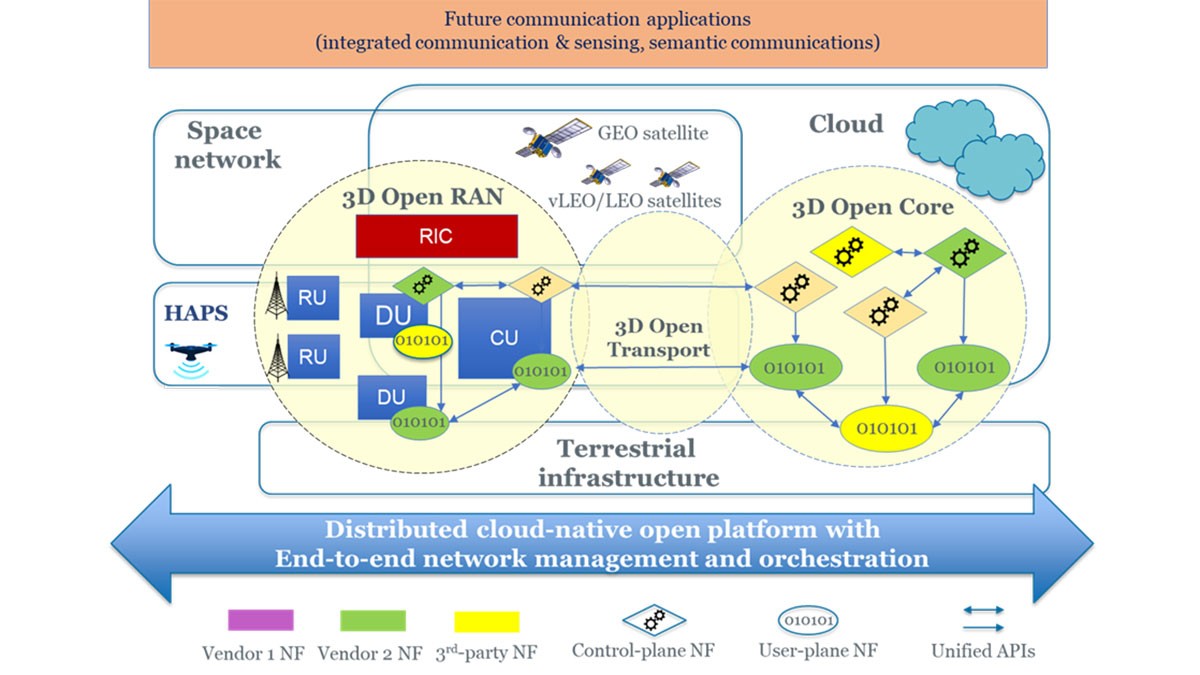
Our approach
The TUDOR project promotes the principle of end-to-end openness across radio access network (RAN), transport and core network segments. Therefore, technologies to enable flexible network disaggregation with seamless interoperability support are designed and developed.
Overview

Figure 1 - presents the overall research landscape of the TUDOR Project towards 6G. The solution takes the existing Open RAN principles and framework and extend them to the rest of the network segments, namely transport/core network and the service platform, leading towards the realisation of a fully end-to-end open network architecture.
Each open network segment (RAN, transport, and core) can be flexibly realised on top of any (combinations) of the 3D network infrastructures, namely space, airborne and terrestrial networks where appropriate. The solution also enables cloud-native support of end-to-end open networks covering both 3D RAN and core segments.
In this architecture, Open RAN functions are extended to non-terrestrial network (NTN) segments which include low/medium/geostationary Earth orbit (LEO/MEO/GEO) satellites, HAPS/UAVs, and their combinations from both economic and performance points of views. Efficient spectrum sensing and sharing techniques are also investigated in the context of the open 3D network environments.
Flexible network function disaggregation
The network function disaggregation includes both generic network functions traditionally provided by equipment vendors, and third-party embedded, application-specific functions, such as those for sensing and media processing introduced by vertical service providers.
The solution exhibits full plug-and-play features where new functions can be seamlessly and securely integrated into the existing open 3D network platform, regardless of the corresponding network segments (RAN or core), or locations (terrestrial, HAPS or space), or at the edge/central cloud.
Container-based solutions with unified APIs, including both inter-vendor and inter-provider interfaces are developed based on the 3D open network architecture. Flexible deployment of functions and network management is enabled through new time-synchronised, highly scalable distributed cloud-native solutions.
6G oriented applications and services
6G oriented applications and services are also investigated in the TUDOR project, for instance integrated communication and sensing (ISAC) and semantic communications.
ISAC is a rapidly evolving technology that is motivated by the increasing demand for radar and communication systems that reuse a common hardware platform and antennas, and share the same or overlapping frequency bands. The TUDOR project team has been investigating near-field ISAC channel models, novel massive-MIMO-based mono-static or bistatic sensing solutions, robust waveform design and optimisation, as well as physical-layer security for ISAC.
Semantic communication is the other 6G-oriented topic being investigated in TUDOR, and the objective is to substantially reduce the date rate requirements by transmitting semantic information rather than the original data where applicable. In this context, research challenges being tackled in TUDOR involves the design of novel source-channel coding schemes and other supporting mechanisms to enable reliable and accurate transmission of semantic information in relevant bandwidth-hungry multimedia applications such as holographic teleportation.
Automation in network management and orchestration
The TUDOR project develops a novel network management and orchestration framework with maximum automation in 3D open network operations according to different emerging business models.
One key design requirement is to tackle the substantially increased management complexity while retaining the high degree of automation in relevant management activities both within and across network boundaries.
Therefore, we propose a novel approach of intent-based network management framework empowered by digital twins, where different collaborative operators can flexibly express their business/operational intent in managing their own resources which can be automatically translated into optimised network configurations. A sophisticated digital twin platform for 3D open network is developed for real-life RAN/network conditions as well as helping to verify the outcome of experimental intents.